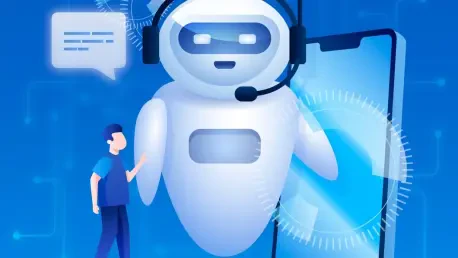The landscape of customer service has undergone a seismic shift with the advent of voicebots, transforming how businesses connect with their clientele in ways that were unimaginable just a decade ago. Picture a scenario where a frustrated customer, stuck in the endless loops of a traditional Interactive Voice Response (IVR) system, suddenly finds resolution through a seamless, human-like conversation with an AI-powered voicebot. This isn’t just a vision—it’s the reality for many companies today. With call wait times shrinking and satisfaction scores climbing, voicebots are no longer a novelty but a cornerstone of modern customer support. This roundup gathers diverse opinions, tips, and reviews from industry leaders, tech innovators, and market analysts to explore how voicebots are revolutionizing customer service, comparing contrasting views on their impact, challenges, and future potential.
The Rise of Voicebots: Transforming Customer Interactions
Industry perspectives converge on the idea that voicebots, driven by advancements in Natural Language Processing (NLP) and Generative Large Language Models (LLMs), have dismantled the barriers of outdated IVR systems. Many experts highlight how these AI agents excel at deciphering customer intent, tone, and context, delivering responses that feel personal rather than robotic. A recurring theme is the drastic reduction in call wait times, with some reports indicating improvements of up to 40% in resolution speed compared to traditional methods.
However, not all opinions are uniformly positive. Certain analysts caution that while the technology is impressive, it still struggles with deeply emotional or highly complex queries. Skeptics argue that overhyping voicebots risks setting unrealistic expectations, pointing out instances where customers felt frustrated by AI’s inability to grasp nuanced issues. This divide underscores a broader debate: whether current capabilities are truly transformative or merely a stepping stone to more refined solutions.
Hybrid Models: Balancing AI and Human Touch
A significant point of agreement among industry voices is the value of the bionic contact center—a hybrid model where voicebots handle routine tasks while human agents tackle intricate, empathy-driven interactions. Many sources praise this collaboration for its scalability, noting that AI can manage high-volume calls, such as account inquiries, freeing agents to focus on building rapport with customers facing unique challenges. Examples abound of companies using voicebots for initial identification before smoothly transferring calls to humans with AI-generated summaries in tow.
Contrasting views emerge on the risk of over-reliance on automation. Some industry watchers warn that leaning too heavily on voicebots could erode trust if customers perceive a lack of personal connection. Others counter that with proper design—such as seamless handoff protocols and continuous AI training—these risks are minimal. This tension reveals a critical balancing act: leveraging efficiency without sacrificing the human element that often defines exceptional service.
Technological Frontiers: Agentic AI and Beyond
Looking at cutting-edge developments, numerous tech innovators are excited about the shift toward agentic AI, where voicebots evolve into systems capable of independently selecting tools and knowledge to address unscripted problems. Enthusiasts argue this could redefine customer experience (CX) by offering hyper-personalized solutions in real time. Adoption trends vary, with tech-savvy markets embracing these advancements rapidly, while regulated sectors like healthcare remain cautious due to compliance concerns.
Differing opinions surface on whether full automation should be the end goal. A segment of thought leaders advocates for a human-centered approach, insisting that technology should amplify rather than replace personal interaction. They suggest that agentic AI’s potential lies in supporting agents as strategic overseers rather than eliminating their roles entirely. This perspective challenges businesses to prioritize empathy alongside innovation as they integrate these emerging capabilities.
Measuring Success: Metrics and Benchmarks in Voicebot Integration
When it comes to evaluating voicebot effectiveness, there’s broad consensus on the importance of specific metrics like Repeat Story Rate, Agent Ramp-up Time, and Post-Handoff Customer Satisfaction (CSAT). Industry analysts emphasize that these benchmarks ensure smooth transitions between AI and human agents, maintaining a cohesive customer journey. Leading companies are often cited for refining these metrics to track performance and identify gaps in hybrid models.
Yet, opinions differ on how these measurements will evolve. Some predict that as AI becomes more sophisticated over the next few years, from 2025 onward, metrics will shift to assess emotional intelligence and personalization depth. Others believe the focus will remain on operational efficiency, arguing that cost savings and speed will continue to dominate evaluation criteria. This divergence highlights an ongoing discussion about whether customer service success is best measured by numbers or by qualitative impact.
Practical Tips for Adopting Voicebot Technology
For businesses eager to embrace voicebots, a variety of practical advice emerges from the field. Many recommend starting with pilot programs focused on automating routine queries, allowing for controlled testing and adjustment before full deployment. Investing in robust AI training to ensure seamless handoffs to human agents is another widely endorsed strategy, as it minimizes disruptions during complex interactions.
Selecting the right voice AI partner also garners diverse suggestions. Some experts advise aligning with established Contact Center as a Service (CCaaS) providers for integrated solutions, while others champion niche specialists for tailored automation in specific industries. A common thread across these tips is the need to align technology choices with distinct CX goals, ensuring that voicebots enhance rather than complicate service delivery.
Reflecting on the Voicebot Revolution
Looking back, the insights gathered from various industry perspectives paint a vivid picture of voicebots as both a disruptive force and a collaborative ally in customer service. The discussions reveal a shared recognition of AI’s power to streamline operations and elevate experiences, tempered by thoughtful debates on balancing automation with empathy. For businesses moving forward, the next steps involve piloting voicebot initiatives with clear metrics in mind, while also fostering a culture that values human connection. Exploring partnerships with AI providers tailored to specific needs emerges as a practical path to sustainable integration. Ultimately, the journey with voicebots suggests a future where technology and humanity can coalesce to redefine service excellence.









